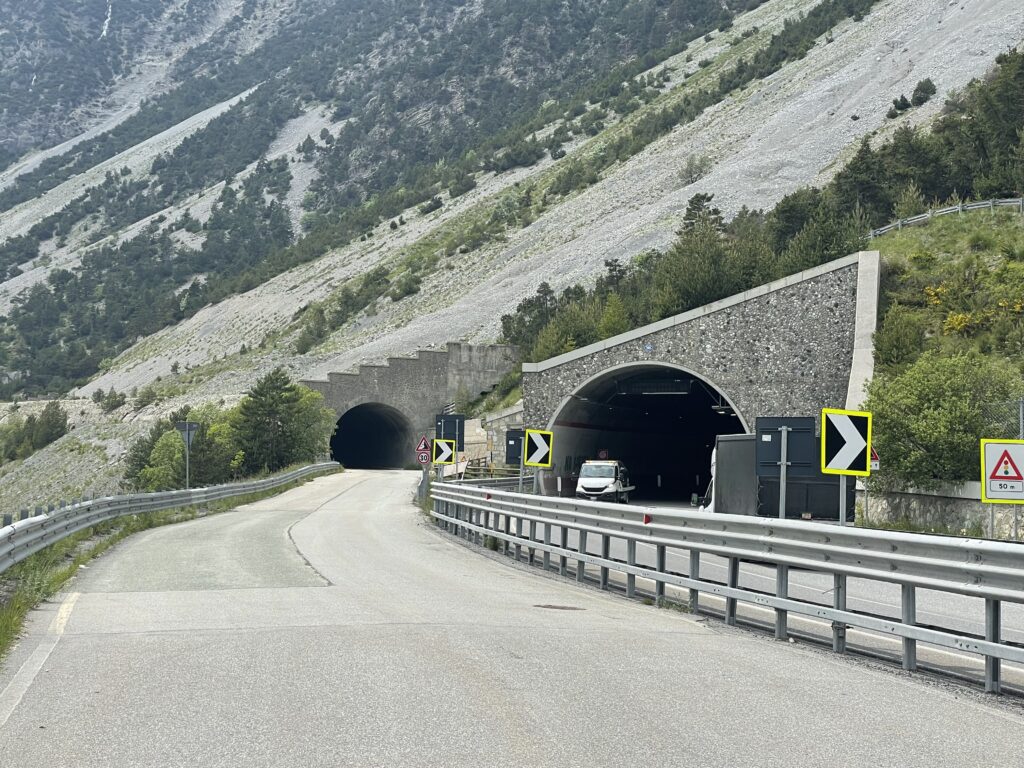In which Sid and Doris meet a true pilgrim and go over another of Napoleon’s cols, going to Briancon and back to alpine France.
By 10.00 there has been good progress, here looking down at Salbertrand. Leg rest or view opportunity?
There is a lot of climbing today, so Idle Sid is keen to find a coffee stop with plug or he will end up with the luggage. The first is at Oulx. yes, really.
A much better stop is at Cessna Torinese, where there are electric bike charging points just as there are for cars. And while that happens, S and D find a refuel zone of their own, which is right on the Compostella route.
Sid chats up a passing pilgrim and invites her to join S and D for lunch. She is a young, crew-cut, open-faced sergeant in the Portuguese equivalent of the RAF Regiment, defending airfields. Her most recent posting was to NATO bases in Lithuania. Two things coincide. She feels she needs a sabbatical during which to improve her approach to command and she has the overseas pay to take time out.
So, as a genuine spiritual pilgrim, she is walking from Lisbon via St Jacques de Compostelle and the Francigena to Rome. Then taking the route down to Bari before a path through Greece and Turkey to get to Jerusalem. The situation in Syria will mean a flight. She has been walking since February. Just to get to Bari must be 4,000 kms. Bold work. She is a joy to meet. And our day feels better for it.
Some of the roads up the valley have been quite trafficked. We have put on bold reflective jackets and the LED backlight for the tunnels. A longer less busy route was considered. Much joy that having chosen the more direct way that, where there are new truck traffic tunnels, the old ones have been reserved for cyclists.
Sid and Doris take a lot of pictures. Occasionally one has composition and subject all coming together. This may be Sid’s favourite of the trip, except those of Doris of course.
A bit more climbing and there you are where Italian Claviere becomes French Montgenevre.
It was over this pass that Napoleon took an army to fight on the Vistula and the Oder. From this un-restored plaque you can sense the ambivalent modern attitude to Napoleon’s imperial ambitions, though you can clearly read the adulation of 1807 and ’55.
Briancon in the Hautes Alpes department and proudly France’s highest city, was heavily defended (against the Austrians, much given to Empire themselves) with a Vauban fort in the high town. Vauban was military engineer to Louis 14th and his 17th century forts are built to a pattern. It may be time to visit one again soon, but today is not that day. Besides, the town is so steep that having passed the fort there is no going back with these legs.
More recently, in 1940 French artillery silenced the Italian fort at Chaberton. The June armistice left large parts of France unoccupied but in the hands of a puppet government. Germany took the whole country in 1942 and came to Briancon in 1943. There were people hiding out from forced labour conscription and scattered resistance forces of various political leanings each aiming to both oust their common enemy, while positioning themselves for future power.
Allied forces with many French North African troops landed in Provence on 15th August 1944. The initial landing was 150,000 and eventually about 600,000, mostly Americans of the Sixth Army Group. The role of these forces is not so well covered on street corners. But then who knew John Doe?
Briancon was freed in August, retaken by German troops and finally liberated on September 6th. There are many memorials to the local fallen and a more recent plaque to their colonial troops.
Briancon is now a mountain sport and motorbike touring town. There are a lot of BMWs again while Opel and Citroen are owned by the same firm.
The town is on the Via Domitia, another branch of the Compostella to Rome route. More famously it is at the foot of the vairy steep Col d’Izoard, much used on the Tour de France. S and D will ride some of the Izoard boucle – tomorrow.



